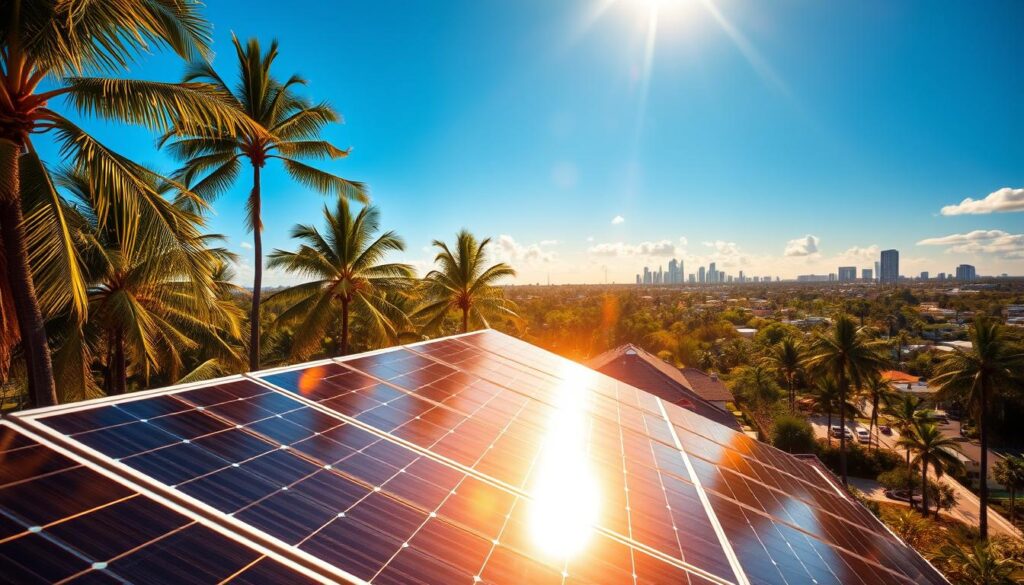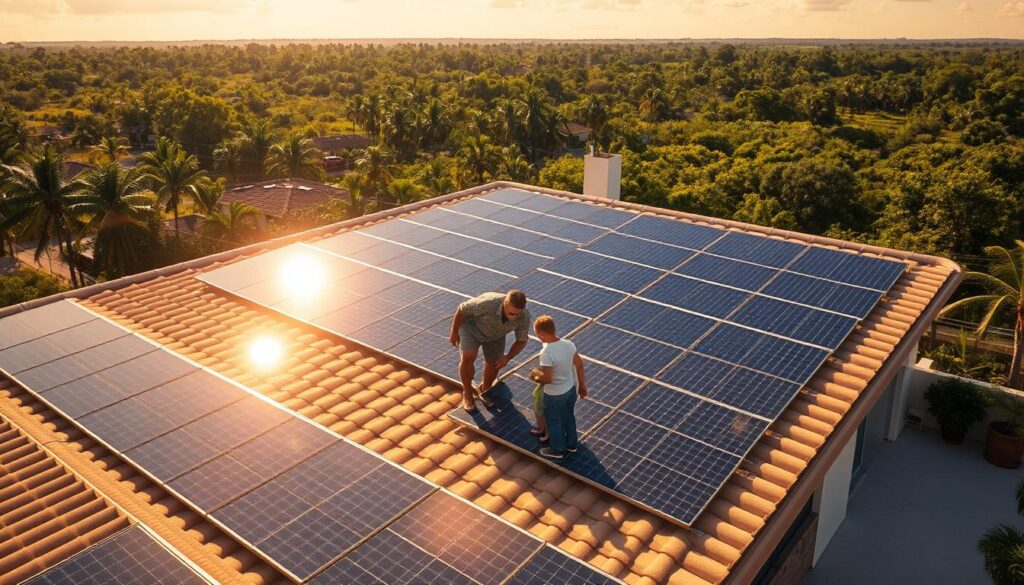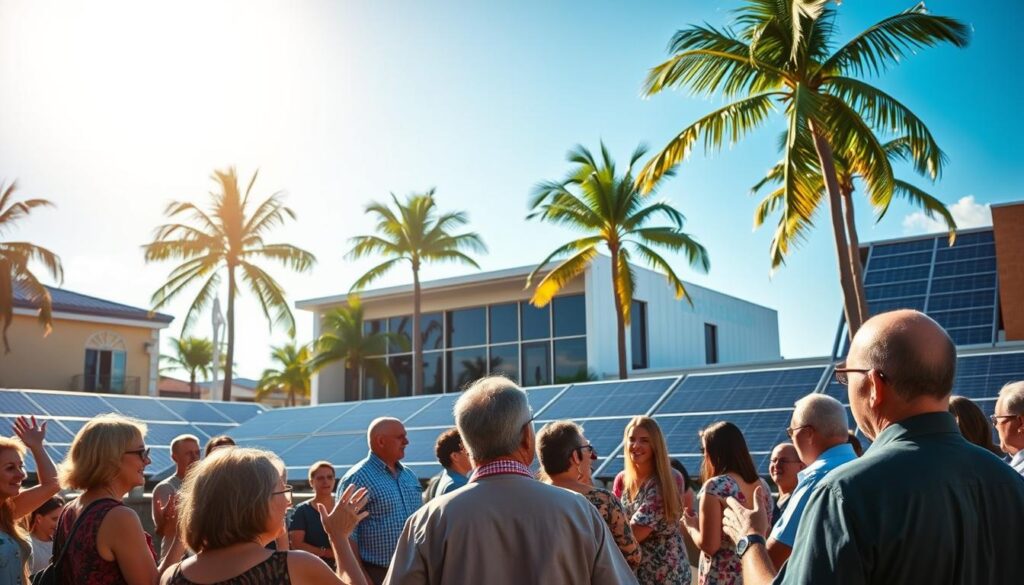Florida’s nickname, the “Sunshine State,” clashes with its lagging solar adoption. Despite adding 2,499 megawatts of solar capacity in early 2023—surpassing California and Texas—solar still supplies just 6% of Florida’s electricity. With over 2 million homes powered by its 12,612 megawatts of installed solar, the state trails California’s 41,675 megawatts and Texas’s 18,801 megawatts. Why does a state with ideal sunlight struggle to lead in solar power?
Recent growth highlights both progress and barriers. Florida Power & Light added 1,769 megawatts in 2023, yet 86% of new installations came from utilities, not homeowners. Policies like net metering exist, but bans on third-party solar ownership and property tax hikes for solar adopters complicate adoption. Even as the U.S. solar market nears 32 gigawatts of new capacity in 2023, Florida’s solar expansion has slowed compared to earlier years.
Key Takeaways
- Florida ranks third in U.S. solar capacity but generates only 6% of its electricity from solar.
- Utility companies added most new solar capacity, with rooftop installations lagging due to policy hurdles.
- Despite 2023’s record growth, Florida’s solar policies create barriers like property tax increases and limited third-party ownership options.
- Over 14,000 Floridians work in solar, yet market growth has slowed amid high interest rates and regulatory challenges.
- The state’s solar potential remains untapped, with 8.15% of its energy now solar despite abundant sunlight.
The Sunshine State: A Solar Paradise?
Florida’s reputation as the solar power in the Sunshine State is backed by its natural advantages. With over 230 days of sunshine annually, the state’s solar insolation ranks among the highest in the U.S. This abundant sunlight makes it a prime location for clean energy systems.
Abundant Sunshine Compared to Other States
| State | Rank in Solar Capacity | Annual Sunshine Days |
|---|---|---|
| California | 1 | 280+ |
| Texas | 2 | 250 |
| Florida | 3 | 230 |
Florida’s ranking reflects its solar potential, yet only 1% of homes use solar. The state’s peak sun hours between 10 a.m. and 2 p.m. maximize energy output.
Ideal Weather Conditions for Solar Energy
- Mild winters reduce snow/ice buildup on panels.
- Summer storms rarely block sunlight long-term.
- Optimal tilt angles (25–30 degrees) and south-facing panels boost efficiency.
Take Hillsborough County’s Solar Co-op: 130 households installed systems, generating 1.2 MW and saving $4.4 million over 25 years. The benefits of solar panels in Florida also include rebates like Dunedin’s $2,500 credit. Even partial shade from trees can be managed with proper design, ensuring panels stay productive year-round.
Florida’s climate avoids extremes that hinder northern states. With minimal snow and brief rain showers, panels stay clean and functional. This reliability turns sunlight into steady savings for users like Janet Stanko, whose bill dropped to $15.44 monthly.
Existing Incentives for Solar Adoption
Florida solar energy incentives aim to simplify the transition to solar power. Federal and state programs reduce costs, encouraging more homeowners to install panels. Here’s how these programs work:
Federal Tax Credits for Homeowners

Since 2017, the federal government offers a tax credit of 30% for solar installations. This non-refundable credit applies to panels, inverters, and storage systems. For example, a $30,000 system in 2025 would save $9,000 upfront. Eligible expenses include installation labor, wiring, and batteries. Taxpayers can roll over unused credits for up to five years.
State-Specific Programs in Florida
Florida’s solar policies focus on cost cuts. Residents avoid 6% sales tax on solar equipment, saving thousands. Net metering programs also let users earn credits for energy sent back to the grid. Local programs like the Boynton Beach Energy Edge offers $1,500 rebates for 5kW+ systems, while Tallahassee’s utility loans provide 5% interest rates.
- Sales tax exemption since 1997
- Property tax exemptions for solar systems
- PACE loans with terms up to 25 years
Combined with federal credits, these tools aim to increase solar adoption in Florida by lowering upfront costs. While no state tax credits exist, these programs help offset the average $33,091 installation cost. With payback periods as low as 8 years, incentives make solar a long-term investment worth exploring.
Challenges to Widespread Solar Adoption
Why aren’t there more solar panels in Florida? Two key issues block progress: high costs and restrictive rules. Even in the Sunshine State, thechallenges of solar energy in Floridapush many families away from going solar.
Initial Installation Costs and Financing
Solar systems cost between$15,000 and $200,000, depending on home size. Rising interest rates have made loans harder to afford. “When rates climb, only wealthier buyers can pay cash,” said solar expert Herriford. Monthly payments for financed systems jump by hundreds when rates hit 6% or higher.
Homeowner Association Restrictions
HOAs often block solar plans, even where state laws prohibit outright bans. “They reject solar panels like they reject colorful fences,” noted advocate Serwatka. Rules may limit panel placement, require “neutral” colors, or delay approvals for years.
Solar’s potential is clear, but these barriers keep many from joining the renewable energy shift.
Utility Company Regulations
Utility companies in Florida heavily influence solar panel regulations in Florida through policies affecting installation and billing. These rules create hurdles for homeowners seeking to adopt solar energy, shaping the state’s renewable landscape.
How Utilities Affect Solar Panel Installation
Florida’s tiered system divides solar systems into three categories based on capacity, impacting costs and requirements:
- Tier 1 (≤10 kW): No fees, no insurance
- Tier 2 (10–100 kW: $1M liability insurance and fees
- Tier 3 (>100 kW: Requires FPSC review and permits
Utilities like Florida Power & Light (FPL) push policies favoring their interests. For example, FPL donated $10,000 to Sen. Jennifer Bradley, sponsor of SB 1024, which sought to eliminate net metering credits post-2023. Such actions highlight how utility agendas clash with challenges of solar energy in Florida.
The Impact of Net Metering Policies
“We must balance innovation with affordable energy access.” – Florida Public Service Commission 2023 Report
Net metering, enforced in 2008, lets households sell excess power at retail rates. But utilities have lobbied to reduce these benefits. Gov. Ron DeSantis vetoed SB 1024 in 2022, citing inflation concerns, but debates continue. Under current rules, unused credits annually revert to utilities at 3–4 cents/kWh, far below retail value.
Proposed changes threaten solar viability: a 2023 survey found 93% of homeowners would abandon solar if net metering were axed. Meanwhile, utilities like FPL plan to build 900 MW of solar projects by 2025 under the Solar Siting and Operations Act, prioritizing utility-owned systems over residential adoption.
Public Awareness and Education
Florida’s push for solar energy hinges on public understanding of its benefits of solar panels in Florida. Schools like Miami-Dade County Public Schools are leading by example, installing solar arrays that cut energy bills and teach students about sustainability. MAST@FIU’s 114-panel system, generating 5-10% of the school’s energy, saves $5,500 yearly. Such projects highlight how promoting solar energy in Florida can empower communities.
Understanding the Benefits
Modern solar technology delivers more than cost savings. Systems like FPL’s 30-million-panel goal by 2030 aim to boost energy independence and reduce carbon footprints. Schools and homes using solar reduce grid strain, especially during hurricanes by storing power locally. Orlando’s SolarTogether program even lets users support solar projects remotely, aligning with MDCPS’s target of 100% clean energy by 2030.

Common Misconceptions
- Myth 1: Solar doesn’t work in cloudy weather. Fact: Panels still generate energy even in Florida’s frequent storms.
- Myth 2: Hurricanes damage panels. Fact: Certified systems withstand 110 mph winds—matching Florida building codes.
- Myth 3: Solar takes decades to pay off. Fact: Systems often recoup costs within 5-7 years through savings and incentives.
Education programs, like Orlando Science Center’s rooftop arrays, show solar’s reliability. By addressing myths and showcasing success stories, Florida can bridge the gap between potential and adoption.
Competition with Other Energy Sources
Florida’s sunny skies make it a prime candidate for solar power in the Sunshine State, yet natural gas remains a major competitor. With just 6% of the state’s electricity coming from solar, traditional energy sources still dominate. Here’s why:
Natural Gas: Why It Still Dominates Florida’s Grid
- Florida utilities rely on existing natural gas infrastructure, making it cheaper to maintain than transitioning to solar.
- Utilities like Florida Power & Light (FPL) invest heavily in gas plants, creating resistance to renewable shifts.
- Over 90% of Florida’s energy mix depends on fossil fuels, locking in long-term contracts.
Solar vs. Non-Renewable Energy Economics
A key hurdle? Stable utility rates. FPL’s slow rate hikes reduce urgency for homeowners to switch. As
“FPL hasn’t raised prices enough to incentivize solar adoption,”
says analyst John Herriford. Even with federal tax credits (30% ITC in 2024), many see little financial urgency.
But momentum grows. Solar installation costs have dropped over 50% in two years, and energy storage tech improves. For increasing solar adoption in Florida, price parity with gas could tip the scales. Florida’s rooftop solar potential ranks third nationally, yet policies like bans on third-party solar contracts hinder progress.
Local Government Initiatives
Florida’s cities and counties are driving progress through proactive policies. Promoting solar energy in Florida now includes streamlined permitting and tax breaks. From Miami to Jacksonville, local governments are removing barriers to adoption.
Key Florida solar energy incentives include:
- Expedited permit approvals for solar installations in Orlando and Tampa
- Zero property taxes on solar equipment in cities like Sarasota
- Boynton Beach’s $1,500 rebate for high-efficiency rooftop systems

Community solar programs are expanding access. Residents unable to install panels can join shared systems through programs like:
| Program | Location | Annual Savings |
|---|---|---|
| JEA Battery Incentive | Jacksonville | $4,000 battery rebate |
| OUC Solar Thermal Rebate | Orlando | $900 for water heating systems |
| Florida Keys DER Loans | Florida Keys | Up to $35k low-interest loans |
These initiatives align with Florida’s goal of 30% renewable energy by 2030. Cities like Tallahassee now offer free solar assessments for low-income households. Even utilities like JEA are closing coal plants to prioritize clean energy, reducing carbon emissions by billions of pounds annually.
Climate Change and Its Impact
Climate change is reshaping how Floridians approach energy. Benefits of solar panels in Florida now include disaster resilience and environmental protection. With 34 climate-linked disasters since 2020, solar power in the Sunshine State offers a lifeline against rising seas and extreme weather.
Increasing Awareness About Environmental Issues
Florida voters are taking notice. A 2022 survey found 84% of voters support net metering policies, even among Republicans. The Inflation Reduction Act’s 30% tax rebate boosts adoption, showing how environmental concerns and incentives align. Younger homeowners lead this shift, prioritizing sustainability over traditional energy sources.
Florida’s Vulnerability to Natural Disasters
Storms like Hurricane Ian expose grid weaknesses. Solar systems with battery backups kept homes powered during 2022’s outages. Florida’s 3 gigawatts of utility-scale solar built in 2024 reflect growing demand for reliable energy. Solar power in the Sunshine State also reduces fossil fuel reliance, cutting emissions driving climate threats.
“Solar+storage is now a necessity, not a luxury,” said a 2023 resilience report.
As sea levels rise and storms intensify, solar adoption isn’t just eco-friendly—it’s practical. Every panel installed today safeguards homes and combats the very forces threatening Florida’s future.
Solar Technology Advancements
Florida’s solar future is brightening with cutting-edge innovations. New panel designs now capture more sunlight, even in hot climates, making solar panel installation in Florida a smarter choice. Modern tech like bifacial panels and half-cut cells boost energy output, turning smaller roofs into efficient power generators.
- Bifacial panels: Harvest light from both sides, boosting energy yield by up to 15%.
- Half-cut cells: Reduce energy loss, ideal for Florida’s humid, sunny days.
- High-temperature tolerance: Panels maintain performance even in extreme heat, a key benefit for Florida homes.
Storage tech is equally transformative. Home batteries now pair seamlessly with solar systems, storing energy for nights or emergencies. Florida’s hurricane-prone climate makes this critical. FPL’s goal of 4 GW of energy storage by 2033 highlights this shift—already, their current 520 MW capacity powers thousands of homes.
| Land Use Type | % of Solar Projects |
|---|---|
| Grassland/Pastureland | 45.7% |
| Agricultural Land | 34.9% |
| Timberland | 13.2% |
Florida’s utilities are scaling up fast. FPL’s 20,000 MW solar target by 2045 will power millions, while projects like Bighorn (300 MW) and Comanche (150 MW) show progress. The benefits of solar panels in Florida extend beyond savings—they strengthen grid resilience. With federal tax breaks under the Inflation Reduction Act, costs drop, making solar more accessible. These advancements aren’t just technical—they’re reshaping Florida’s energy landscape, one panel at a time.
The Role of Nonprofits and Advocacy Groups
Nonprofits and advocacy groups are driving change in Florida’s energy landscape. Their work focuses on promoting solar energy in Florida through education, policy advocacy, and community partnerships. These efforts aim to make solar more accessible, especially for low-income households.
Key organizations like the Florida Solar Energy Industries Association (FSEIA) and the Southern Alliance for Clean Energy lead initiatives to increase solar adoption in Florida. Their strategies include:
- Advocating for fair net metering policies
- Training installers and certifying solar professionals
- Raising awareness about federal incentives like the Inflation Reduction Act’s 30% tax credit
Organizations Promoting Solar Energy
FSEIA’s data highlights progress: 17,055 MW of solar capacity now powers over 2 million homes. Their programs connect nonprofits to grants like the Solar for All initiative, which allocated $156 million for rooftop installations. For example, 10,000 single-family homes in Florida will get subsidies covering 60–100% of costs. The Justice40 Initiative ensures 40% of benefits reach historically marginalized communities.
Grassroots Movements in Florida
Local groups like Community Solar Co-ops leverage bulk purchasing to lower costs. Their efforts have sparked a ripple effect: every solar installation inspires 100 more in five years. Below is a snapshot of Solar for All’s impact:
| Program | Florida Funding | Households Helped |
|---|---|---|
| Solar for All | $156,120,000 | 10,000 homes |
| Justice40 Initiative | 40% of funds to marginalized communities | 900,000 households nationwide |
By combining advocacy with grassroots action, these groups are turning Florida’s sun into a tool for equity and affordability. Their efforts align with federal goals to cut emissions and create 14,000+ solar jobs across the state.
Future Prospects for Solar Energy in Florida
Florida’s solar potential remains vast, and upcoming trends suggest a bright path ahead. As the state ranks third nationally in solar capacity, advancements in technology and policy could reshape its energy landscape. Let’s explore how these changes might answer the question: why aren’t there more solar panels in Florida? today—and what’s next.
Predictions for Growth by 2030
By 2030, Florida aims to install 19,367 megawatts of solar capacity, tripling its current output. Falling costs and rising demand drive this shift. Solar panel installation in Florida has already surged, with 14,108 jobs added in 2023 alone. As prices drop—down 37% in a decade—more homeowners and businesses may adopt clean energy. Innovations like hurricane-resistant panels and better storage systems also address past challenges, making solar viable even in storm-prone regions.
Potential Changes in Legislation and Policy
State policies could amplify this progress. Proposed updates to net metering rules and tax incentives might streamline solar panel installation in Florida. Florida’s legislature could also boost renewable targets, mirroring California’s push for 100% clean energy. Federal support, like extended tax credits, would further cut costs. Meanwhile, new building codes might require solar-ready homes, tackling HOA restrictions that once slowed growth. These steps could finally bridge the gap between Florida’s sunny potential and its current 7% solar energy share.
Florida’s journey to becoming a solar leader hinges on balancing innovation, policy, and public support. With its sunny climate and growing demand, the state is poised to turn today’s questions into tomorrow’s solutions.
